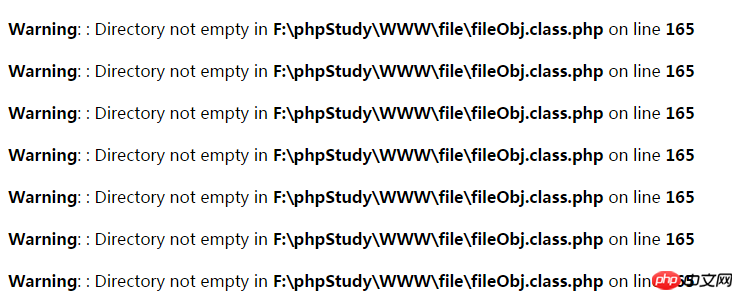Home >Backend Development >PHP Tutorial >Detailed explanation of the function of deleting specified folders in PHP
Detailed explanation of the function of deleting specified folders in PHP
- 巴扎黑Original
- 2017-09-08 15:20:231255browse
The following editor will bring you an example of how to delete a specified folder in PHP. The editor thinks it’s pretty good, so I’ll share it with you now and give it as a reference. Let’s follow the editor and take a look
1. Preface
2. Introduction to related functions
The method of operating PHP files is roughly the same. It has been introduced in the previous article. I will not repeat the introduction here. Here I will introduce a new one. Functionrmdir

3. Code composition
**
* [delAllFile description] 删除指定目录
* @param [type] $dirName [description] 目录
* @param [type] $file [description] 记录的过程文件
* @param integer $type [description] 第一次默认打开新文件,第二次调用不打开
* @return [type] [description]
*/
public function delAllFile($dirName, $file, $type = 1) {
$re = $this->checkDir($dirName);
//默认第一次打开文件
if($type){
$file = fopen($file, 'w');//打开日志文件
}
if($re){
$this->delFile($dirName, $file);
}else{
fwrite($file,"{$dirName}清理完成\r\n");
}
}
/**
* [checkDir description] 检测文件夹是否为空,为空直接删除
* @param [type] $dirName [description] 文件夹名
* @return [type] [description]
*/
private function checkDir($dirName) {
$a = scandir($dirName);//列出 images 目录中的文件和目录:
//只包含.和..目录的文件夹为空文件夹
if(sizeof($a) == 2){
rmdir($dirName);
return false;
}
return true;
}
/**
* [delFile description] 上传文件的方法
* @param [type] $dirName [description] 目录
* @param [type] $file [description] 记录的文件
* @return [type] [description]
*/
private function delFile($dirName, $file) {
$dh = openDir($dirName);
while($handle = readdir($dh)){
if($handle == '.' || $handle == '..') {
continue;
}
$resource = $dirName.'/'.$handle;
//判断是否是文件夹
if(is_dir($resource)) {
//判断文件夹是否为空
$re = $this->checkDir($dirName);
if($re){
$this->delAllFile($resource, $file, 0);
}else{
fwrite($file,"{$resource}清理完成\r\n");
continue;
}
}else{
unlink($resource);
}
}
//关掉资源,删除目录
closedir($dh);//关闭目录资源
fwrite($file,"{$dirName}清理完成\r\n");
rmdir($dirName);//删除空目录
}However, the above When the code encounters a high-level subdirectory, a warning will easily appear, causing the directory to be unable to be deleted

// //关掉资源,删除目录
// closedir($dh);//关闭目录资源
// fwrite($file,"{$dirName}清理完成\r\n");
//rmdir($dirName);//删除空目录
//每次目录层级高了就报错,故加个循环处理
$i = 1;
while($i){
$re = $this->checkDir($dirName);
echo "$dirName $i 次<br/><hr/>";
$i++;
if(!$re){
$i = 0;
closedir($dh);//关闭目录资源
fwrite($file,"{$dirName}清理完成\r\n");
}
} Adding this layer can avoid the situation of being unable to delete (sometimes the inability to delete is a permissions issue)
4. Conclusion
Deleting a directory is relatively simple. The basic steps are: 1. Determine whether it is a directory. , if it is a directory, call itself recursively, otherwise the file will be deleted directly; 2. Determine whether the directory is empty. If it is not empty, rmdir will throw an error; 3. File permission issues (window , this is not a problem)The above is the detailed content of Detailed explanation of the function of deleting specified folders in PHP. For more information, please follow other related articles on the PHP Chinese website!
Statement:
The content of this article is voluntarily contributed by netizens, and the copyright belongs to the original author. This site does not assume corresponding legal responsibility. If you find any content suspected of plagiarism or infringement, please contact admin@php.cn
Previous article:Detailed explanation of how to prevent hotlinking using PHPNext article:Detailed explanation of how to prevent hotlinking using PHP

